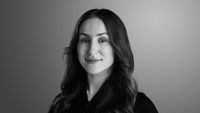

When it comes to building core strength your mind probably immediately goes to those classic exercises that require you to lay on the floor: dead bugs, planks, bird dogs (to name a few). These are, without a doubt, top-notch exercises, but none of these have graced my four weekly workout sessions and my core is the strongest it’s ever been. The exercise I’ve been doing? The barbell front squat.
Now, I know what your probably thinking, ‘doesn’t that target your lower body?’. The front squat is in fact a multi-joint movement, a compound exercise that targets serval muscles in the body at once. These include your lower body muscles, such as the quads, glutes and hamstrings, but it also ignites your core muscles and far more than a back squat does.
This is because the centre of mass is on the front of your body. As a result, your deep core muscles (the transverse abdominis, internal obliques and erector spinae muscles) have to work extra hard to keep your body upright. If they don’t? You’ll cave forward and drop the bar. It’s a humbling exercise, especially when swapping over from a regular squat.
But, the great thing about them is it’s an accessible exercise as there are so many variations of the front squat, you don’t have to do them with a barbell. You could use dumbbells, a kettlebell (and do a goblet squat), a sandbag, or you could even fill a backpack with some books at home and hold it to your chest.

Despite finding them more difficult than back squats, I personally find front squats far more rewarding. I’ve been doing them four times a week for more than four months now, gradually building up to 80kg. This is how I know my core has been progressively getting stronger because, if it wasn’t, I would be dropping the bar, as there’s really no where to hide with the front squat!
A stronger core has also led to other advantages; I can now deadlift more weight than ever before, my lower back pain is almost near to none meaning I can perform everyday tasks far more comfortably, and I’ve definitely noticed a nice muscle boost in my quads (as front squats target this muscle more than the back squat).
Speaking of the lower back, the National Academy of Sports Medicine say there is anecdotal evidence that front squats place less pressure on the lower back than front squats.
Get all the latest news, reviews, deals and buying guides on gorgeous tech, home and active products from the T3 experts
Guaranteed, front squats may not have blessed me with a rippling six-pack (and they’re not going to). But, what it has given me is far more valuable and will see me being able to move my body for the better in the long run which is worth its weight in gold.
How to do a front squat
The barbell front squat is quite an advanced exercise that requires good shoulder and wrist mobility, so I’m going to focus this example on the dumbbell front squat, as it is more accessible. If this is still too hard, then the goblet squat is a fantastic regression and far more comfortable. Also, don’t forget to watch the video above so you can see, visually, how the movement looks.
A great addition to your lower body or full-body workouts, here’s how you do them…
- Begin by standing with your feet a little wider than shoulder-width apart and your heels turned out slightly
- Pick up your dumbbells and hold them on your shoulders, keeping your elbows high and pointing straight ahead (try not to let them slouch too much)
- Take in a deep breath to brace your core, then push your hips back and squat down so that your thighs are parallel, or lower, to the floor
- Hold here for a second then push through your feet and stand back up to the starting position

Bryony’s T3’s official ‘gym-bunny’ and Active Staff Writer, covering all things fitness. She is a certified personal trainer and also a part-time fitness instructor. In her spare time, you will find her in her natural habitat - the gym - where her style of training is a hybrid of bodybuilding and powerlifting. Bryony loves writing about accessible workouts, nutrition and testing innovative fitness products that help you reach your fitness goals and take your training to the next level.
